Corporate Accounting and Reporting Solution - Semester 2
VerifiedAdded on 2021/05/31
|7
|1462
|25
Homework Assignment
AI Summary
This assignment solution delves into the core concepts of corporate accounting and reporting, focusing on the determination of recoverable amounts and the application of impairment tests. It elucidates the process of calculating the value in use, which involves estimating future cash flows and appl...
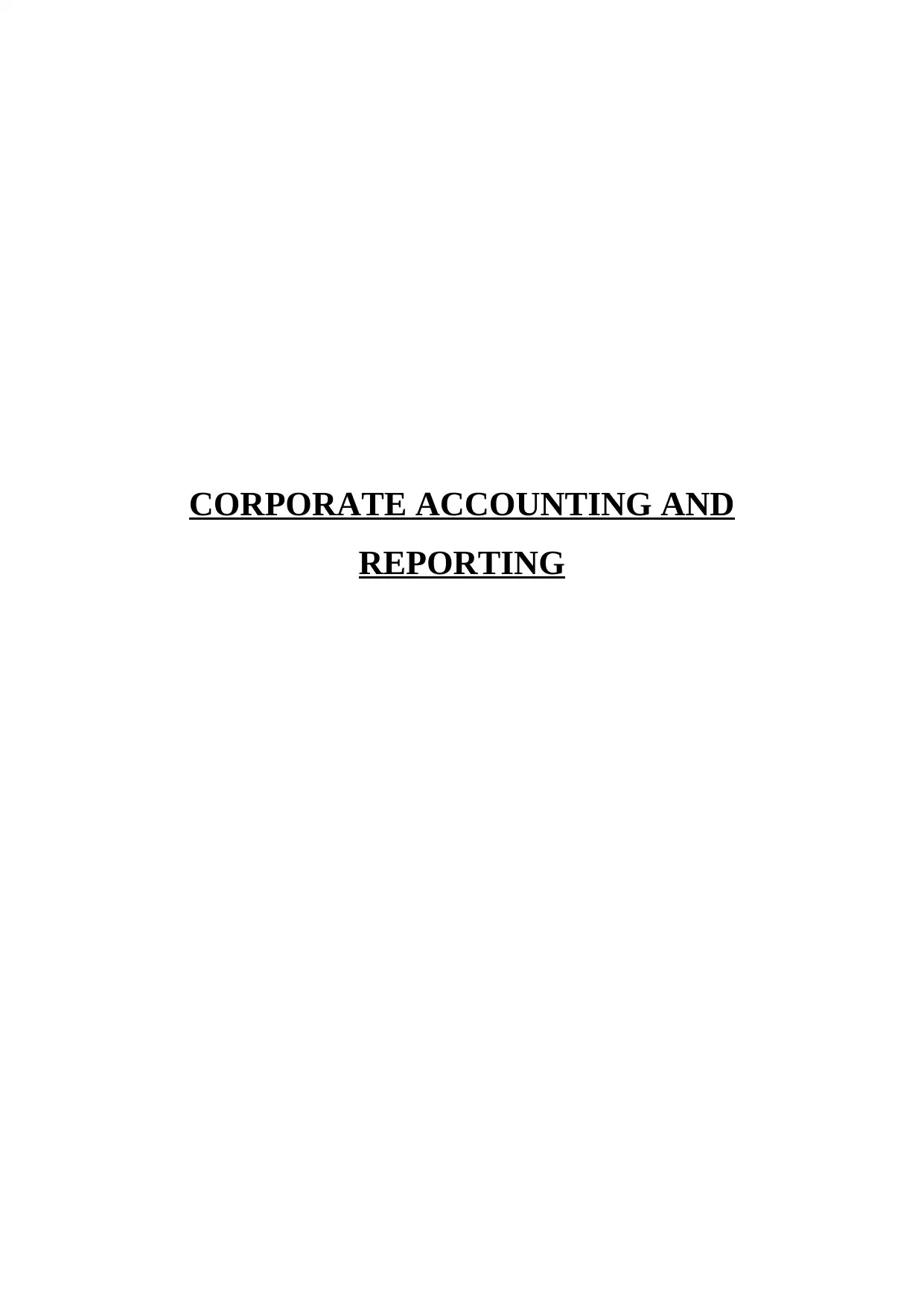
CORPORATE ACCOUNTING AND
REPORTING
REPORTING
Paraphrase This Document
Need a fresh take? Get an instant paraphrase of this document with our AI Paraphraser
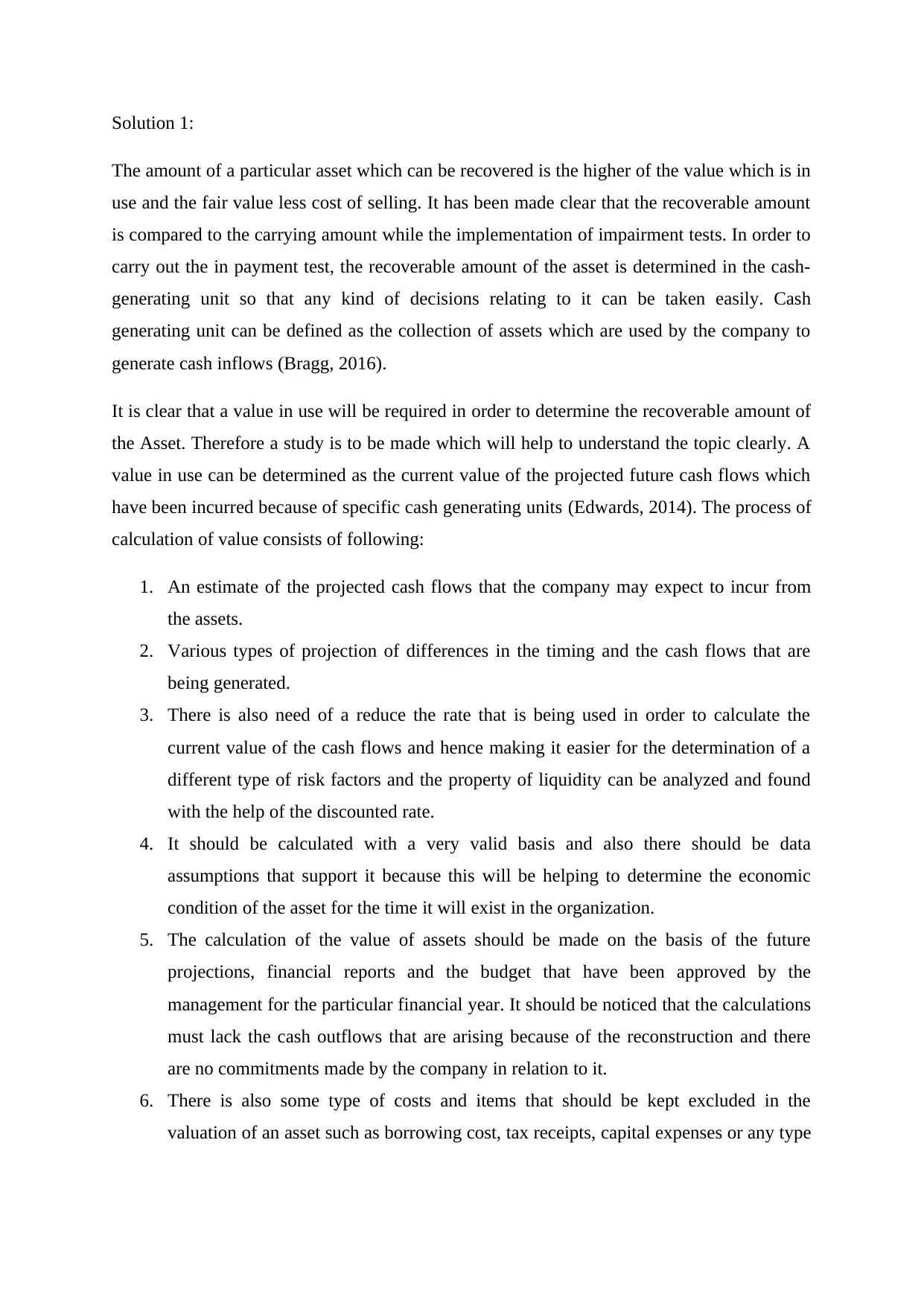
Solution 1:
The amount of a particular asset which can be recovered is the higher of the value which is in
use and the fair value less cost of selling. It has been made clear that the recoverable amount
is compared to the carrying amount while the implementation of impairment tests. In order to
carry out the in payment test, the recoverable amount of the asset is determined in the cash-
generating unit so that any kind of decisions relating to it can be taken easily. Cash
generating unit can be defined as the collection of assets which are used by the company to
generate cash inflows (Bragg, 2016).
It is clear that a value in use will be required in order to determine the recoverable amount of
the Asset. Therefore a study is to be made which will help to understand the topic clearly. A
value in use can be determined as the current value of the projected future cash flows which
have been incurred because of specific cash generating units (Edwards, 2014). The process of
calculation of value consists of following:
1. An estimate of the projected cash flows that the company may expect to incur from
the assets.
2. Various types of projection of differences in the timing and the cash flows that are
being generated.
3. There is also need of a reduce the rate that is being used in order to calculate the
current value of the cash flows and hence making it easier for the determination of a
different type of risk factors and the property of liquidity can be analyzed and found
with the help of the discounted rate.
4. It should be calculated with a very valid basis and also there should be data
assumptions that support it because this will be helping to determine the economic
condition of the asset for the time it will exist in the organization.
5. The calculation of the value of assets should be made on the basis of the future
projections, financial reports and the budget that have been approved by the
management for the particular financial year. It should be noticed that the calculations
must lack the cash outflows that are arising because of the reconstruction and there
are no commitments made by the company in relation to it.
6. There is also some type of costs and items that should be kept excluded in the
valuation of an asset such as borrowing cost, tax receipts, capital expenses or any type
The amount of a particular asset which can be recovered is the higher of the value which is in
use and the fair value less cost of selling. It has been made clear that the recoverable amount
is compared to the carrying amount while the implementation of impairment tests. In order to
carry out the in payment test, the recoverable amount of the asset is determined in the cash-
generating unit so that any kind of decisions relating to it can be taken easily. Cash
generating unit can be defined as the collection of assets which are used by the company to
generate cash inflows (Bragg, 2016).
It is clear that a value in use will be required in order to determine the recoverable amount of
the Asset. Therefore a study is to be made which will help to understand the topic clearly. A
value in use can be determined as the current value of the projected future cash flows which
have been incurred because of specific cash generating units (Edwards, 2014). The process of
calculation of value consists of following:
1. An estimate of the projected cash flows that the company may expect to incur from
the assets.
2. Various types of projection of differences in the timing and the cash flows that are
being generated.
3. There is also need of a reduce the rate that is being used in order to calculate the
current value of the cash flows and hence making it easier for the determination of a
different type of risk factors and the property of liquidity can be analyzed and found
with the help of the discounted rate.
4. It should be calculated with a very valid basis and also there should be data
assumptions that support it because this will be helping to determine the economic
condition of the asset for the time it will exist in the organization.
5. The calculation of the value of assets should be made on the basis of the future
projections, financial reports and the budget that have been approved by the
management for the particular financial year. It should be noticed that the calculations
must lack the cash outflows that are arising because of the reconstruction and there
are no commitments made by the company in relation to it.
6. There is also some type of costs and items that should be kept excluded in the
valuation of an asset such as borrowing cost, tax receipts, capital expenses or any type
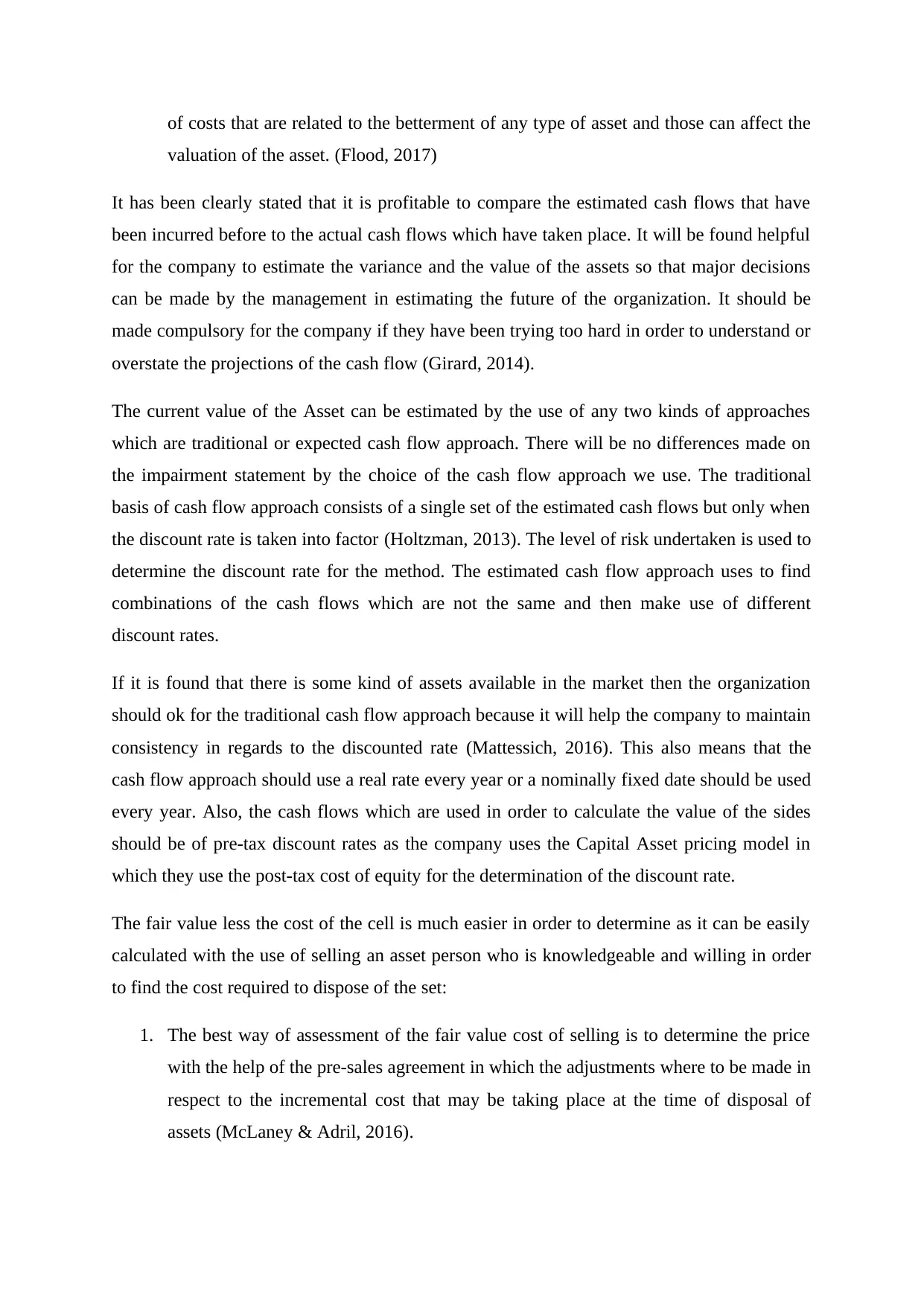
of costs that are related to the betterment of any type of asset and those can affect the
valuation of the asset. (Flood, 2017)
It has been clearly stated that it is profitable to compare the estimated cash flows that have
been incurred before to the actual cash flows which have taken place. It will be found helpful
for the company to estimate the variance and the value of the assets so that major decisions
can be made by the management in estimating the future of the organization. It should be
made compulsory for the company if they have been trying too hard in order to understand or
overstate the projections of the cash flow (Girard, 2014).
The current value of the Asset can be estimated by the use of any two kinds of approaches
which are traditional or expected cash flow approach. There will be no differences made on
the impairment statement by the choice of the cash flow approach we use. The traditional
basis of cash flow approach consists of a single set of the estimated cash flows but only when
the discount rate is taken into factor (Holtzman, 2013). The level of risk undertaken is used to
determine the discount rate for the method. The estimated cash flow approach uses to find
combinations of the cash flows which are not the same and then make use of different
discount rates.
If it is found that there is some kind of assets available in the market then the organization
should ok for the traditional cash flow approach because it will help the company to maintain
consistency in regards to the discounted rate (Mattessich, 2016). This also means that the
cash flow approach should use a real rate every year or a nominally fixed date should be used
every year. Also, the cash flows which are used in order to calculate the value of the sides
should be of pre-tax discount rates as the company uses the Capital Asset pricing model in
which they use the post-tax cost of equity for the determination of the discount rate.
The fair value less the cost of the cell is much easier in order to determine as it can be easily
calculated with the use of selling an asset person who is knowledgeable and willing in order
to find the cost required to dispose of the set:
1. The best way of assessment of the fair value cost of selling is to determine the price
with the help of the pre-sales agreement in which the adjustments where to be made in
respect to the incremental cost that may be taking place at the time of disposal of
assets (McLaney & Adril, 2016).
valuation of the asset. (Flood, 2017)
It has been clearly stated that it is profitable to compare the estimated cash flows that have
been incurred before to the actual cash flows which have taken place. It will be found helpful
for the company to estimate the variance and the value of the assets so that major decisions
can be made by the management in estimating the future of the organization. It should be
made compulsory for the company if they have been trying too hard in order to understand or
overstate the projections of the cash flow (Girard, 2014).
The current value of the Asset can be estimated by the use of any two kinds of approaches
which are traditional or expected cash flow approach. There will be no differences made on
the impairment statement by the choice of the cash flow approach we use. The traditional
basis of cash flow approach consists of a single set of the estimated cash flows but only when
the discount rate is taken into factor (Holtzman, 2013). The level of risk undertaken is used to
determine the discount rate for the method. The estimated cash flow approach uses to find
combinations of the cash flows which are not the same and then make use of different
discount rates.
If it is found that there is some kind of assets available in the market then the organization
should ok for the traditional cash flow approach because it will help the company to maintain
consistency in regards to the discounted rate (Mattessich, 2016). This also means that the
cash flow approach should use a real rate every year or a nominally fixed date should be used
every year. Also, the cash flows which are used in order to calculate the value of the sides
should be of pre-tax discount rates as the company uses the Capital Asset pricing model in
which they use the post-tax cost of equity for the determination of the discount rate.
The fair value less the cost of the cell is much easier in order to determine as it can be easily
calculated with the use of selling an asset person who is knowledgeable and willing in order
to find the cost required to dispose of the set:
1. The best way of assessment of the fair value cost of selling is to determine the price
with the help of the pre-sales agreement in which the adjustments where to be made in
respect to the incremental cost that may be taking place at the time of disposal of
assets (McLaney & Adril, 2016).
⊘ This is a preview!⊘
Do you want full access?
Subscribe today to unlock all pages.

Trusted by 1+ million students worldwide
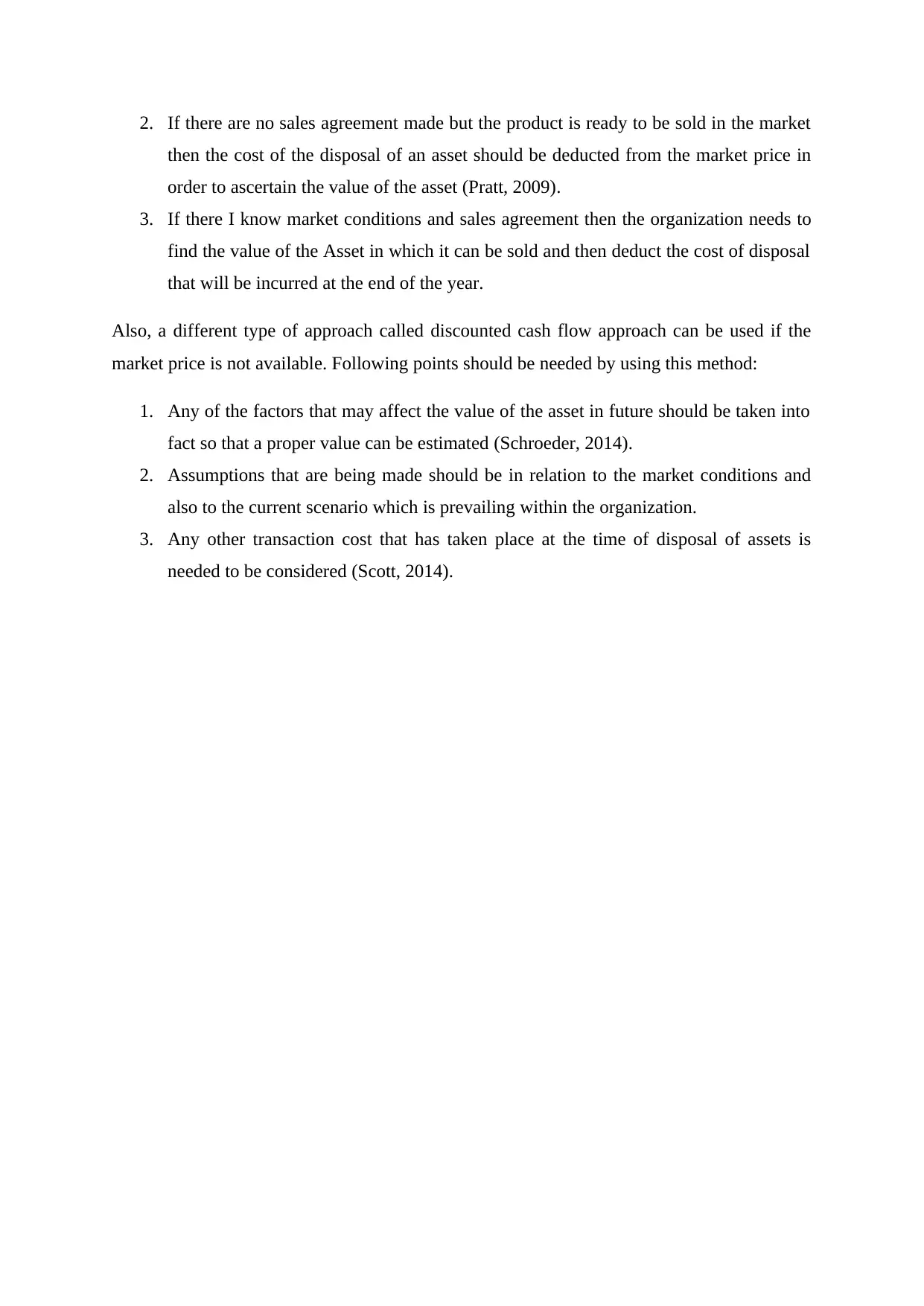
2. If there are no sales agreement made but the product is ready to be sold in the market
then the cost of the disposal of an asset should be deducted from the market price in
order to ascertain the value of the asset (Pratt, 2009).
3. If there I know market conditions and sales agreement then the organization needs to
find the value of the Asset in which it can be sold and then deduct the cost of disposal
that will be incurred at the end of the year.
Also, a different type of approach called discounted cash flow approach can be used if the
market price is not available. Following points should be needed by using this method:
1. Any of the factors that may affect the value of the asset in future should be taken into
fact so that a proper value can be estimated (Schroeder, 2014).
2. Assumptions that are being made should be in relation to the market conditions and
also to the current scenario which is prevailing within the organization.
3. Any other transaction cost that has taken place at the time of disposal of assets is
needed to be considered (Scott, 2014).
then the cost of the disposal of an asset should be deducted from the market price in
order to ascertain the value of the asset (Pratt, 2009).
3. If there I know market conditions and sales agreement then the organization needs to
find the value of the Asset in which it can be sold and then deduct the cost of disposal
that will be incurred at the end of the year.
Also, a different type of approach called discounted cash flow approach can be used if the
market price is not available. Following points should be needed by using this method:
1. Any of the factors that may affect the value of the asset in future should be taken into
fact so that a proper value can be estimated (Schroeder, 2014).
2. Assumptions that are being made should be in relation to the market conditions and
also to the current scenario which is prevailing within the organization.
3. Any other transaction cost that has taken place at the time of disposal of assets is
needed to be considered (Scott, 2014).
Paraphrase This Document
Need a fresh take? Get an instant paraphrase of this document with our AI Paraphraser
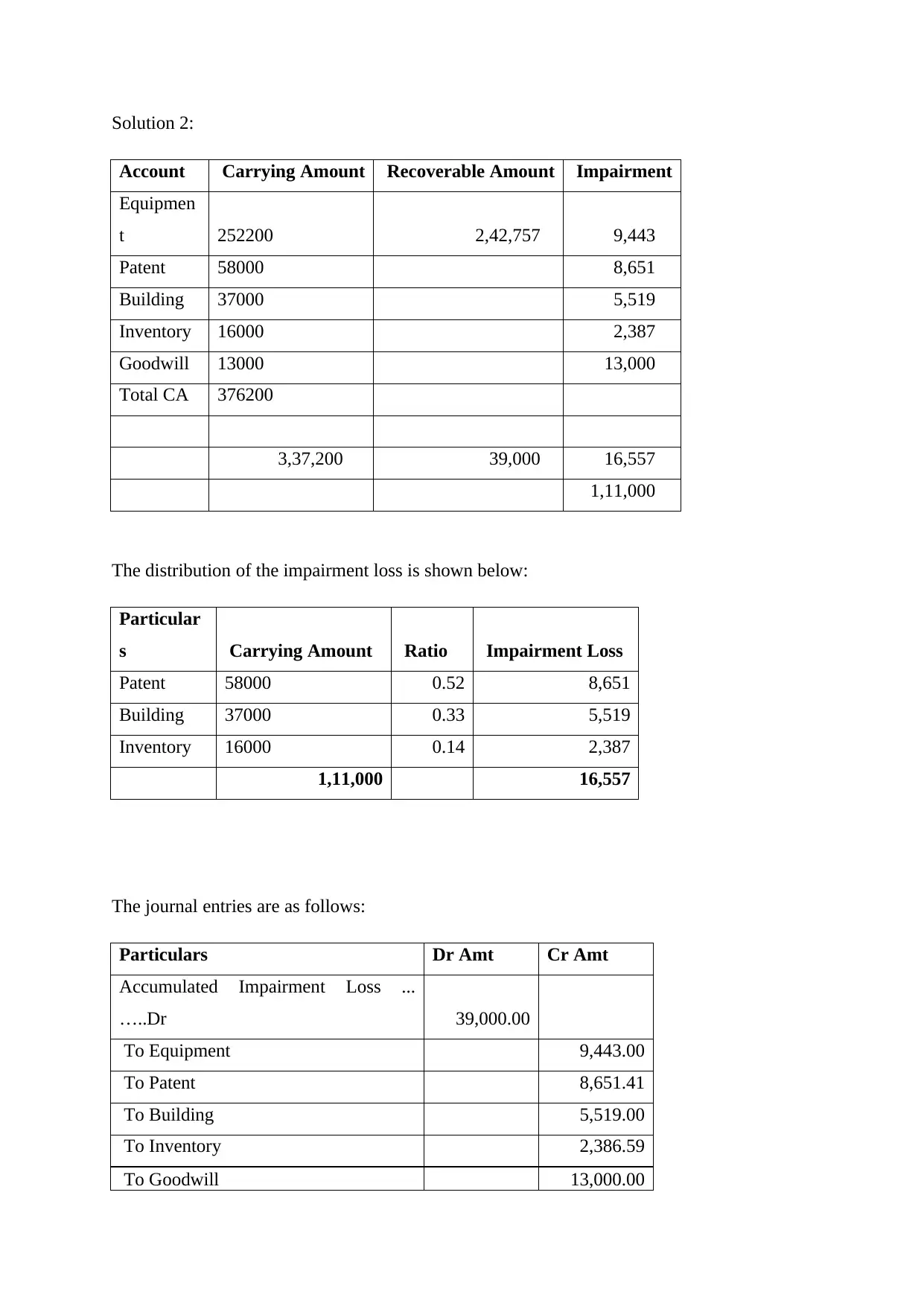
Solution 2:
Account Carrying Amount Recoverable Amount Impairment
Equipmen
t 252200 2,42,757 9,443
Patent 58000 8,651
Building 37000 5,519
Inventory 16000 2,387
Goodwill 13000 13,000
Total CA 376200
3,37,200 39,000 16,557
1,11,000
The distribution of the impairment loss is shown below:
Particular
s Carrying Amount Ratio Impairment Loss
Patent 58000 0.52 8,651
Building 37000 0.33 5,519
Inventory 16000 0.14 2,387
1,11,000 16,557
The journal entries are as follows:
Particulars Dr Amt Cr Amt
Accumulated Impairment Loss ...
…..Dr 39,000.00
To Equipment 9,443.00
To Patent 8,651.41
To Building 5,519.00
To Inventory 2,386.59
To Goodwill 13,000.00
Account Carrying Amount Recoverable Amount Impairment
Equipmen
t 252200 2,42,757 9,443
Patent 58000 8,651
Building 37000 5,519
Inventory 16000 2,387
Goodwill 13000 13,000
Total CA 376200
3,37,200 39,000 16,557
1,11,000
The distribution of the impairment loss is shown below:
Particular
s Carrying Amount Ratio Impairment Loss
Patent 58000 0.52 8,651
Building 37000 0.33 5,519
Inventory 16000 0.14 2,387
1,11,000 16,557
The journal entries are as follows:
Particulars Dr Amt Cr Amt
Accumulated Impairment Loss ...
…..Dr 39,000.00
To Equipment 9,443.00
To Patent 8,651.41
To Building 5,519.00
To Inventory 2,386.59
To Goodwill 13,000.00
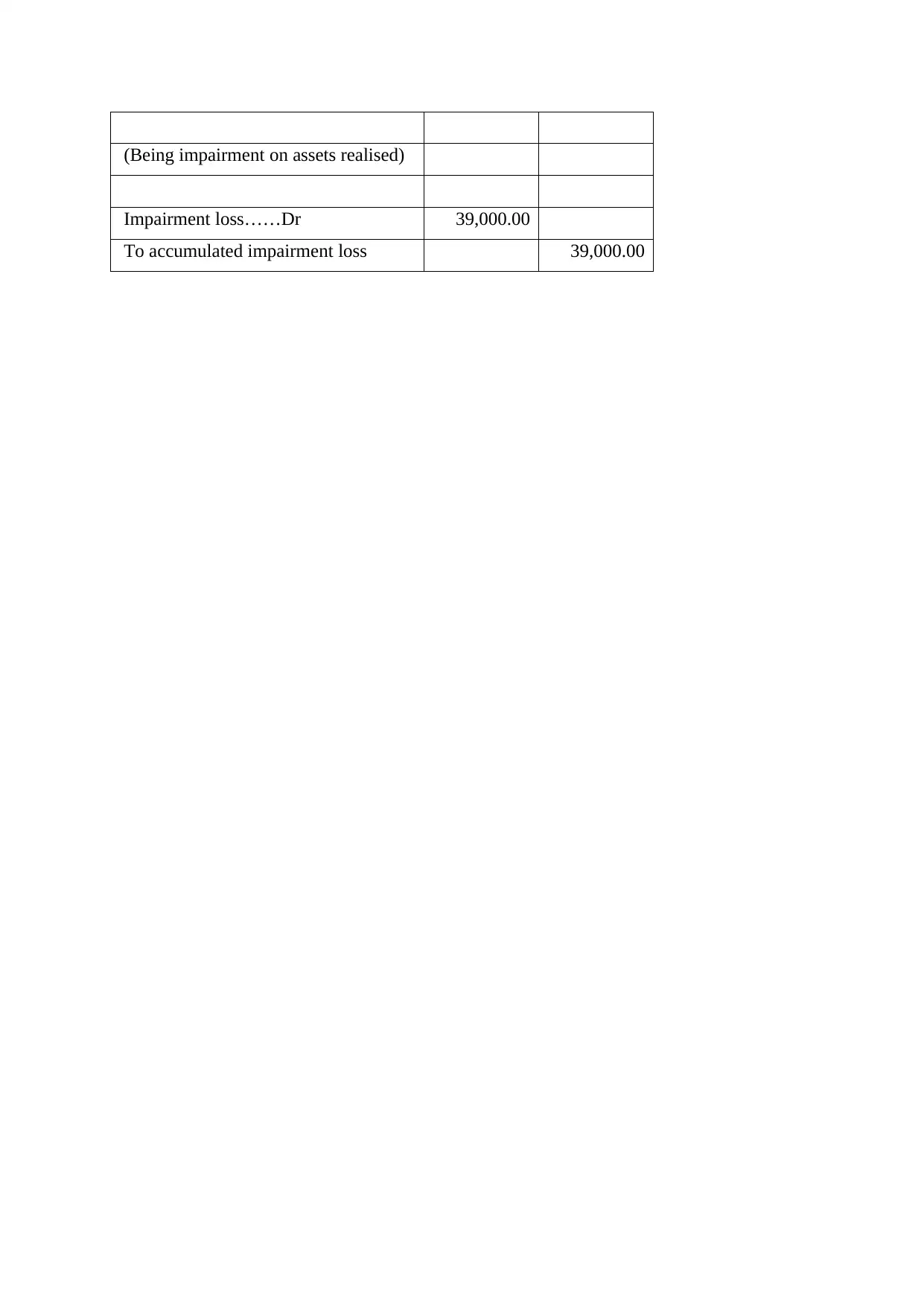
(Being impairment on assets realised)
Impairment loss……Dr 39,000.00
To accumulated impairment loss 39,000.00
Impairment loss……Dr 39,000.00
To accumulated impairment loss 39,000.00
⊘ This is a preview!⊘
Do you want full access?
Subscribe today to unlock all pages.

Trusted by 1+ million students worldwide
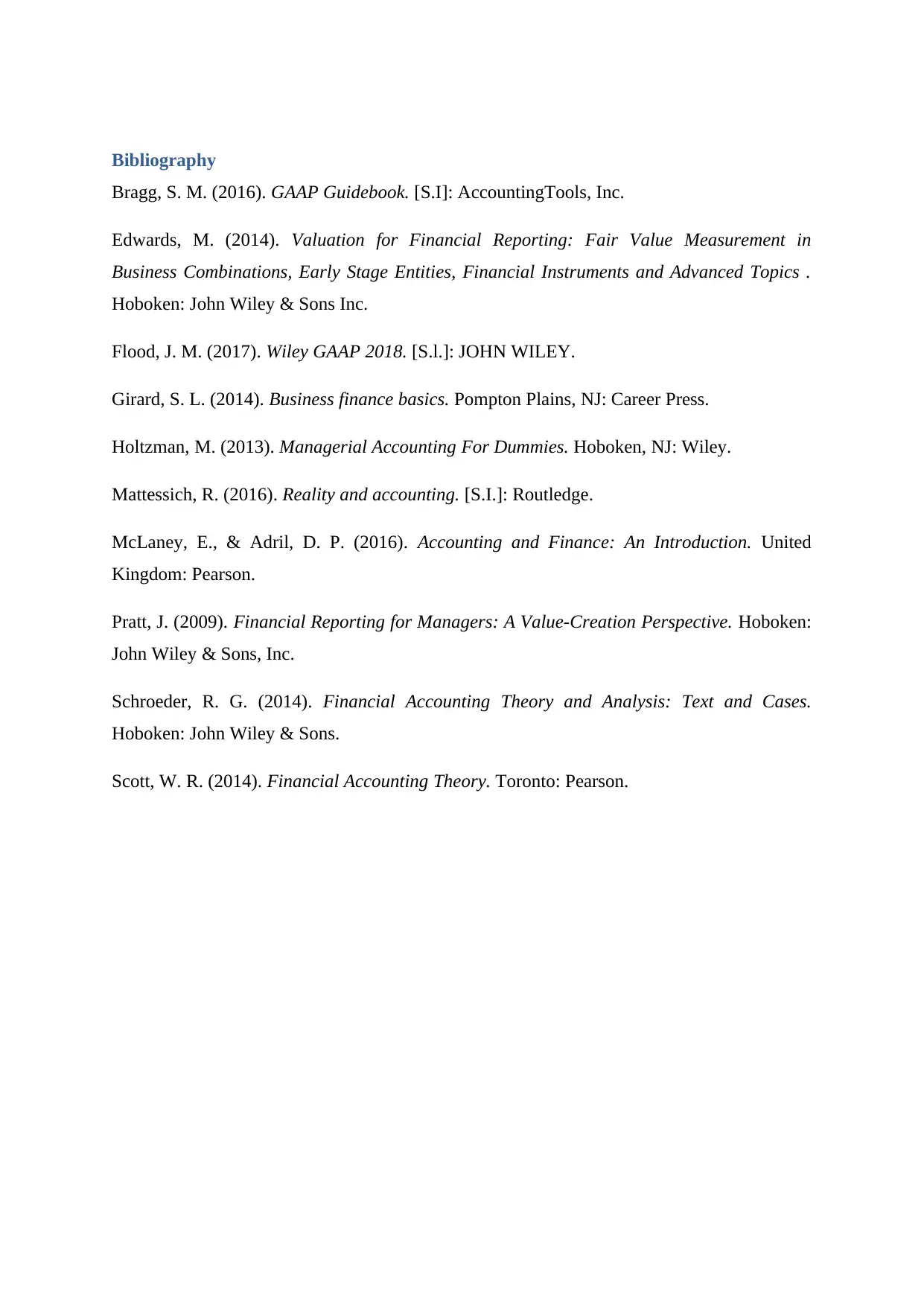
Bibliography
Bragg, S. M. (2016). GAAP Guidebook. [S.I]: AccountingTools, Inc.
Edwards, M. (2014). Valuation for Financial Reporting: Fair Value Measurement in
Business Combinations, Early Stage Entities, Financial Instruments and Advanced Topics .
Hoboken: John Wiley & Sons Inc.
Flood, J. M. (2017). Wiley GAAP 2018. [S.l.]: JOHN WILEY.
Girard, S. L. (2014). Business finance basics. Pompton Plains, NJ: Career Press.
Holtzman, M. (2013). Managerial Accounting For Dummies. Hoboken, NJ: Wiley.
Mattessich, R. (2016). Reality and accounting. [S.I.]: Routledge.
McLaney, E., & Adril, D. P. (2016). Accounting and Finance: An Introduction. United
Kingdom: Pearson.
Pratt, J. (2009). Financial Reporting for Managers: A Value-Creation Perspective. Hoboken:
John Wiley & Sons, Inc.
Schroeder, R. G. (2014). Financial Accounting Theory and Analysis: Text and Cases.
Hoboken: John Wiley & Sons.
Scott, W. R. (2014). Financial Accounting Theory. Toronto: Pearson.
Bragg, S. M. (2016). GAAP Guidebook. [S.I]: AccountingTools, Inc.
Edwards, M. (2014). Valuation for Financial Reporting: Fair Value Measurement in
Business Combinations, Early Stage Entities, Financial Instruments and Advanced Topics .
Hoboken: John Wiley & Sons Inc.
Flood, J. M. (2017). Wiley GAAP 2018. [S.l.]: JOHN WILEY.
Girard, S. L. (2014). Business finance basics. Pompton Plains, NJ: Career Press.
Holtzman, M. (2013). Managerial Accounting For Dummies. Hoboken, NJ: Wiley.
Mattessich, R. (2016). Reality and accounting. [S.I.]: Routledge.
McLaney, E., & Adril, D. P. (2016). Accounting and Finance: An Introduction. United
Kingdom: Pearson.
Pratt, J. (2009). Financial Reporting for Managers: A Value-Creation Perspective. Hoboken:
John Wiley & Sons, Inc.
Schroeder, R. G. (2014). Financial Accounting Theory and Analysis: Text and Cases.
Hoboken: John Wiley & Sons.
Scott, W. R. (2014). Financial Accounting Theory. Toronto: Pearson.
1 out of 7
Related Documents
Your All-in-One AI-Powered Toolkit for Academic Success.
+13062052269
info@desklib.com
Available 24*7 on WhatsApp / Email
![[object Object]](/_next/static/media/star-bottom.7253800d.svg)
Unlock your academic potential
© 2024 | Zucol Services PVT LTD | All rights reserved.





